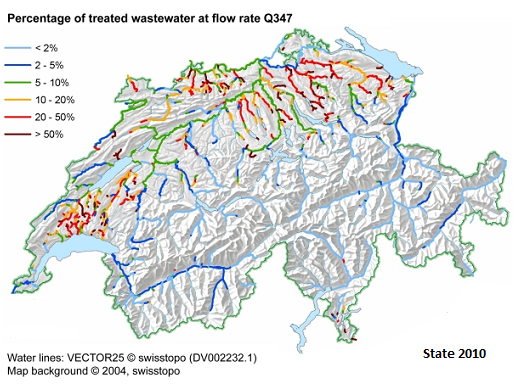Surface water pollution by wastewater
Despite the good upgrade standards of the treatment plants, substances called micropollutants continue to be discharged into watercourses with the wastewater. They originate from everyday products such as medicines, detergents, toiletries etc. Even at low concentrations they can harm aquatic organisms or pollute drinking water resources. The indicator shows which stretches of water have a high percentage of treated wastewater, so that micropollutants can be expected to occur.
 impossible to evaluate
impossible to evaluate
 impossible to evaluate
impossible to evaluate

High percentages of wastewater occur mainly in small to medium-sized rivers in densely populated regions such as the Central Plateau. High concentrations of trace substances occur in these watercourses. A nationwide evaluation of the current state is not possible due to the varied situations in small, medium-sized and large rivers and the different regions of Switzerland.
The trend in the indicator is dependent on climate change (discharge rate in the water) and the makeup of the population in the catchment area of the WTP. Because of the many different factors influencing the trend, it does not make sense to evaluate them. Since the population density in various regions of Switzerland and the periods of low flow are both increasing, it is important to ensure efficient, high-quality wastewater treatment, particularly in densely populated regions, to prevent impacts on aquatic organisms and pollution of drinking water. Measures must also be taken to reduce inputs of micropollutants into surface waters. For example, upgrading to integrate an additional treatment step could double micropollutant elimination in the WTP. The indicator provides guidance on which WTP require an additional treatment step.
On 3rd march 2014, National Council and Council of States agreed to the proposal of the Federal Council to finance at a national level the upgrading of about 100 wastewater treatment facilities to eliminate micropollutants. Therefore, the Water Protection Act is adopted in order to introduce a nationwide wastewater levy (limited until 2040), according to the polluter pays principle. The relevant legal regulations entered into force on 1 January 2016.
- Related indicators
- Nutrients in watercourses
There are no internationally standardised or surveyed data on the percentage of treated wastewater (dilution ratio). This parameter has only recently begun to be debated by international bodies. The percentage of treated waste water is currently compiled in Germany, among others.
The percentage of wastewater is estimated based on the average volume of wastewater treated by the wastewater treatment facility in dry weather. The percentage is calculated for low flow conditions because the wastewater dilution is then at its lowest and the pollution highest.
Further information






